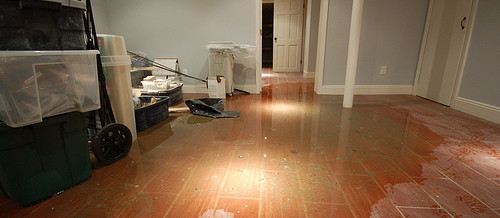Imagine that you head off to work one day and return 8 hours later to discover that one of your appliances had a service line rupture sometime during the day and water escaped into your home.
Now, consider that a even the smallest of water lines, like the 1/4" ice maker line on your fridge, can spill over 4 litres of water per minute if completely split open. That means that even if the leak in your home occurred at noon, you could potentially have almost 1000 litres of water spilled in your house when you return. That's a lot of water and a great way to ruin a relaxing evening, without a doubt.The most common water service line break in a home is usually associated with the washing machine and, being a 5/8" service line, if that happened right after you left the house, over an 8 hour span you'd have 21,600 litres of water leaked. needless to say. That's enough water to turn your basement into an indoor pool. Yikes!
 |
| Small leaks can turn into large ones over time |
And, if the water damage alone isn't enough to ruin your day, think about what happens to all that wet stuff, including your carpeting, furniture and walls, once you do get the water shut off. There's the water to be pumped out and all the damage to the carpet or hardwood floors, drywall, and all your possessions of course.
And we all know that water flows downhill, so it will most certainly find its' way onto any of the floors below the leak, ending up in your basement and affecting your furnace, hot water tank and other appliances.
 |
| Water spreads quickly and even if it's not deep, can damage a lot of items, especially flooring and carpets |
 |
A broken washing machine service line could leak 64,00 litres of water in a 24 hour span and fill a home that has a 20' x 80' footprint with 16" of water
|
Aside from the inconvenience of having no water in your home and a big mess to clean up, there are other issues with which you need to be concerned.
We all know that anything wet or moist has the potential to feed the growth of mold and that one word alone should be enough to prompt you into action. In the case of mold growth, time is of the utmost importance and the longer you wait, the more serious the problems become, with a window of only 24 - 36 hrs being key.
Some serious action needs to occur within that period and, if mitigation starts immediately, you have a better chance of compounding the problems of water escape.
 |
| The stuff you can't see behind walls and ceilings |
 |
| The mold you can see, in this case on the drywall |
 |
| These guys have to wear protective suits and masks for a reason |







No comments:
Post a Comment